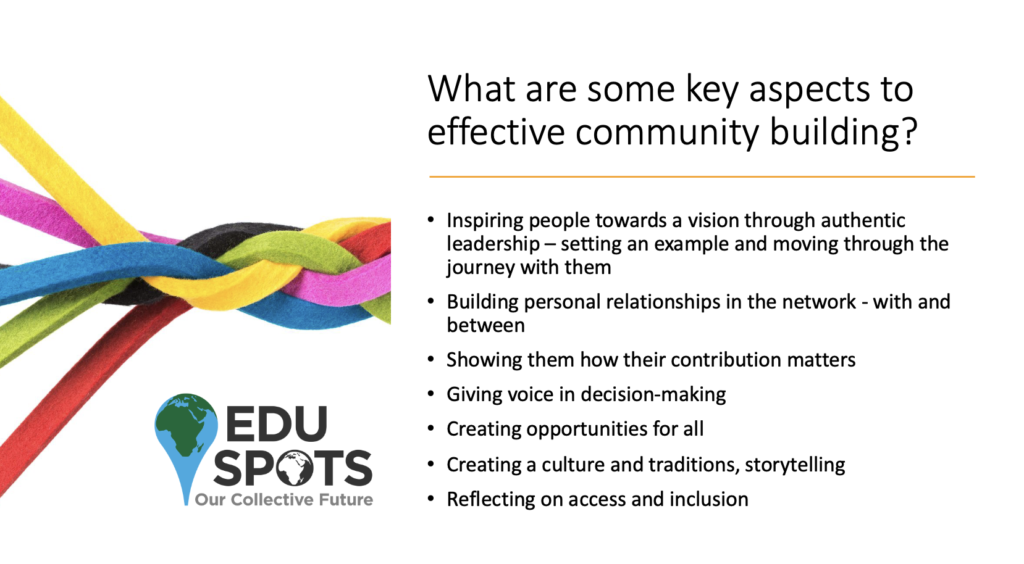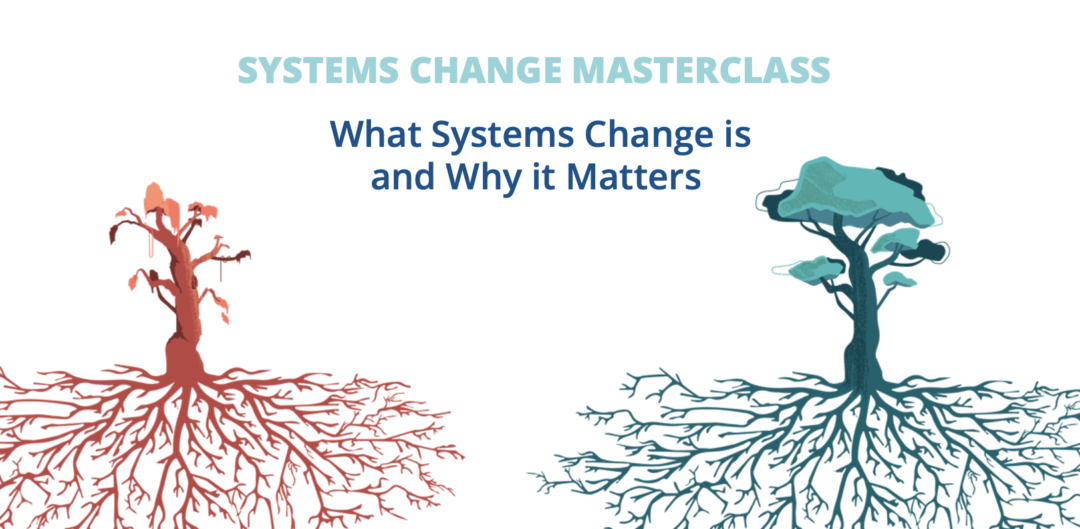Communities don’t just emerge; they are the consequence of intentional acts of inclusion.
Many of us live in places and spaces; many of us work for organisations; but in 2023 the loneliness epidemic demonstrates that not all of us exist within connected communities.
The experience of Covid has shown us that we are rarely entirely self-sufficient as humans with so many of us finding our daily trips to supermarkets vital to ‘purchase’ simple human interaction at the checkout.
We all need to reach for some purpose beyond ourselves, especially during a period of crisis, as shown by the huge surge in volunteerism during the pandemic.
I would not have coped with isolation and uncertainty without throwing myself into what I can only describe on reflection as ‘extreme volunteering’ in my local area in Sevenoaks.
Indeed, volunteering for EduSpots since 2014 has brought me extensive community value and well-being.

This week, I’ve been reading The Connected Community by Cormac Russell and John McKnight, which has led to much reflection on community building towards social change, leading me to consider this question:
How can we strengthen the connectedness of our communities, whether within organisations, neighbourhoods, or online forums?
In the EduSpots context, ‘community’ is a network of 300 local volunteers across rural Ghana and beyond; our community mostly ‘exists’ on WhatsApp, with local community teams building further local communities centred around physical spaces called ‘Spots’.
We are all working towards the vision of what we call ‘Our Collective Future’. This vision is non-descript in some senses because we believe the collaborative creative process itself is central to that future. Indeed, our organisational vision is of ‘a world in which communities unite to create the futures they want to see’.
However, our network members, despite a multiplicity of identities, are broadly united in wanting to make education more equitable, aiming to provide free access to learning resources and quality creative education to all, whilst growing ourselves in this process as leaders and educators.
In growing EduSpots, much of the community-building in our early years was organic; but we’ve learnt that once you reach a certain size, it takes more intention to sustain the same energy, due to the scaled number of relationships to preserve and develop.
The topic is particularly relevant to us as a volunteer network, with growing sub-communities with unique identities developing for literacy, early years education, EcoSTEM, girls’ empowerment, and our Ambassadors’ Network, alongside individual ‘Spots’ forming strong individual communities of volunteers locally.
These are three (of many more) cornerstones of building connected, inclusive and sustainable communities that we’ve observed and found nestled within Russell and McKnight’s inspiring work.
1. Build from the inside out
The vision of the community itself needs to be built from within the participants of the group. Whilst the community might change over time, its overlapping network of members will share an alignment to key aims of progress: creating space to explore these shared areas of value is vital.
‘When you build community from the inside out in the ways we describe here, contrary to what some may assume, you don’t create tribalism, you build resilience. This process includes willingness to welcome the stranger and to invite new ideas and intermediate technologies (simple and practical tools that can be purchased locally or constructed from resources that are available locally) that don’t damage but rather enhance what can be created locally.’ (Cormac Russell and John McKnight, 2022)
Once we have a clear vision in mind, we need to ask ourselves: ‘what talents are already around us in our immediate communities and networks?’ that may be aligned towards that vision.
We need to recognise that people bring gifts (contributions) in diverse forms, and that we need to identify different opportunities to contribute, whether from within the existing community or in new partnerships formed.
In this process, the acts of giving and receiving that are generated are not transactions but rather relational and transformational for all.
The role of ‘connectors’ in this process is vital, and as highlighted by Russell and McKnight, connectors are not necessary the same people as leaders. More on this role coming in future posts!
“Most connectors are people with a special eye for the gifts, the potential, the interests, the skills, the experiences, and the capacities of their neighbours. They focus on those strengths and lift them up for that person and for others in the neighbourhood.” (Cormac Russell and John McKnight, 2022)
2. Enable everyone to foster personal relationships
Linked to the work of connectors, strong communities emerge when members across the group start fostering personal relationship. By personal, I don’t mean necessarily engaging with their family history or day-to-day affairs but knowing factors about the person that are valued by that individual.
For example, on reflection on my well-being, one thing I’ve realised that I often struggled with in the UK, leading to a sense of community disconnection, is when people in my own physical community or working space, don’t understand or even know about my work with EduSpots, which at times has felt like an alternative reality.
People who know me well, see that asking me how EduSpots is going and engaging with some of the complex ethical thinking it involves – and in this beyond the typical surface level summary the majority of people perceive of ‘Africa, poverty, charity – is an easy trick to make me feel at ease and make me feel understood and included.
By ‘personal’, here, we therefore mean engaging in the person’s wider story.
And it’s important that it’s not just the community leaders, staff members or community connectors build these relationships, but that structures and opportunities are created that enable individuals across the community to spark and develop these relationships.
Russell and McKnight give lots of suggestions for activities that can nurture this, including one based around capacities (p180) where 100 skills are placed on cards and people have to collectively sort them into piles of ‘we know who can’, ‘we can’, ‘who else/what else’ and ‘we can’t and don’t know who can’. This offers a structured process by which people start to understand their skills and interests, and individual stories of diverse forms will surely emerge in this process.
3. Encourage everyone to be story writers and storytellers
Aside from knowing something about members’ stories, we also need to build our shared stories with them, and not for them, allowing their voice and experiences to enrich the tapestry of evolving change.
“A culture of connectedness is fostered through story sharing. The sum of the adaptation of such stories over time is known as culture: local cuisine, art, beliefs, language, customs, and so fourth. Culture finds voice through stories.” (Cormac Russell and John McKnight, 2022)
I’ve found that every community whether old or new, whether in-person or online, whether held in space or in the virtual world, generates its own practices and traditions, and the more that these can be generated by those within the group the better, creating circles of meaning only fully understood to those who are participating in the network, creating what Wittgenstein might call ‘language games.’
And it is through continuing practising and sharing our community-bound stories that we are able to maintain culture, whilst engaging with new activities and perspectives, enabling them to bring great richness to our community.
One beautiful aspect of EduSpots, is the diverse nature of the practices across our network of Spots; each local group of volunteers have their own traditions, bound in the cultures of their community and the experiences of developing their Spot.
We encourage every Spot to tell its own story through local and online communication channels, and through group reflections at key points of the year.
We tell Spots to take full ownership of their communication style and brand, whilst giving them training in communication skills and engaging them in our overall vision and branding strategy.
Together, we feel that we are creating an emerging story.
A few other broad thoughts from my team during a collaborative training session on this topic.

Closing thoughts…
And in this process of relationship-building, culture-creating and story sharing, everyone needs to be actively included and this is something we all need to work much harder at, and my experience with ME has certainly given me a new depth of awareness in this regard I couldn’t have gained otherwise.
We need to be wary of excluding people thoughtlessly whether through use of language, pace or place of engagement, the range of roles and responsibilities offered, or the multiplicity of other ways in which exclusion occurs; creating space and a safe and supportive environment for active listening is key.
Mainstream economics cannot see the contribution potential of the marginalised. It sees people on the margins as broken and deficient, as needy, not needed.” (Cormac Russell and John McKnight, 2022)
I increasingly believe many of the world’s challenges can be solved by shifting notions of charity away from acts of giving towards acts of inclusion, recognising that many ‘problems’ emerge through a lack of connection to communities of various forms.
We should not see those who are marginalised as problems to be solved but rather people to be actively included in our emerging story.
_______________________
Here is a simple structure for a collaborative staff training workshop on this topic with the EduSpots team, leading to many practical strategies for employing the above areas.


